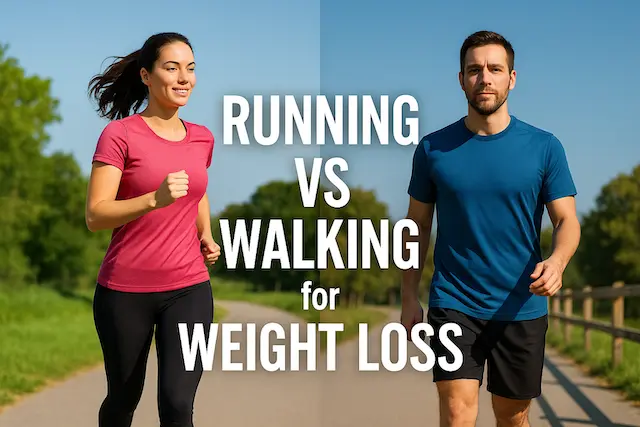
Running vs Walking for Weight Loss
Many people wonder whether running or walking is the more effective way to shed extra pounds. Both exercises burn calories, improve heart health, and boost metabolism, but they do so at different intensities. Understanding these differences helps you choose the approach that fits your goals and lifestyle. In this article, we will explore the science behind running vs walking for weight loss, comparing calorie burn, fat loss, and long-term sustainability to help you decide which one’s best for you.
What’s the real difference between running and walking for weight loss?
Running generally burns more calories in less time, while walking is a lower-impact exercise that’s easier to sustain long term. Both support fat loss and improved fitness, but running’s higher intensity creates a stronger calorie deficit per minute of activity.
The primary distinction lies in exercise intensity and energy expenditure. Running engages more muscle groups, elevates your heart rate, and boosts oxygen consumption, leading to higher calorie burn. In contrast, walking primarily targets fat as an energy source due to its lower intensity, which is why it’s often called a “fat-burning” activity.
Here’s a quick comparison:
- Running: Burns roughly 100 to 120 calories per mile depending on body weight and speed.
- Walking: Burns around 65 to 80 calories per mile for the same individual.
- Impact: Running is a high-impact workout that strengthens bones and muscles but carries a higher injury risk. Walking is low-impact, gentle on the joints, and suitable for beginners or those recovering from injuries.
Pairing regular cardio with nutrient-rich foods can support better energy and recovery. For a simple option, explore the 8 Benefits of Sprouts & Ways to Grow Them In-House. From a metabolic perspective, both activities improve insulin sensitivity, cardiovascular endurance, and resting energy expenditure. However, walking’s lower intensity makes it easier to maintain daily consistency, which is often the most important factor for long-term weight management.
For example, a 70-kg person who walks briskly for one hour burns about 250 to 300 calories. The same person running for 30 minutes at a moderate pace burns roughly 350 to 400 calories. While running wins in efficiency, walking can be done more frequently with less recovery time required.
If your goal is steady, sustainable weight loss without straining your joints, walking can be just as valuable as running, provided you keep up consistency and maintain a balanced diet.
Is walking or running better for weight loss?
Running generally leads to faster weight loss than walking because it burns more calories in less time, but walking can be just as effective when done consistently. Both walking and running support fat loss, muscle tone, and better metabolism, the best choice depends on your fitness level, joint health, and goals.
Running burns more energy per minute since it’s a high-intensity exercise that increases heart rate, oxygen use, and post-exercise calorie burn. This effect, called excess post-exercise oxygen consumption (EPOC), allows your body to keep burning calories even after you stop running.
Walking, on the other hand, is a low-impact activity that primarily uses fat as fuel during exercise. It’s easier to maintain daily and reduces injury risk, which means you’re more likely to stay consistent, a key factor in long-term weight management.
Recent research comparing runners and walkers shows:
- Runners tend to lose more weight quickly because of higher calorie expenditure.
- Walkers achieve steady, sustainable results, especially when walking briskly for at least 45 to 60 minutes a day.
- Both groups see improvements in fat oxidation, heart health, and energy levels when paired with a calorie-controlled diet.
For example, if you run 5 kilometers at a moderate pace, you might burn 300 to 400 calories. Walking the same distance burns closer to 200 to 250 calories, but if you walk daily and stay consistent, that difference can balance out over time.
If you’re starting out or have joint discomfort, walking is the smarter entry point. Once you’ve built endurance, you can include light jogging or interval walking and running sessions to gradually boost calorie burn.
Ultimately, there isn’t a one-size-fits-all answer. Running may deliver faster short-term results, but walking can be equally powerful for sustainable, injury-free weight loss when maintained over time.
How many calories do you burn walking vs running for weight loss?
Running burns more calories per minute than walking, making it more efficient for weight loss, but the total burn depends on your pace, duration, and body weight. On average, running burns about 1.5 times more calories than walking the same distance.
Calorie burn varies based on body weight, speed, and intensity. A heavier person expends more energy because it takes more effort to move a larger mass. Likewise, walking uphill or running faster increases your calorie expenditure.
Here’s a general comparison for a 70-kg (154-lb) individual:
- Running (8 km/h or 5 mph): ~400 to 450 calories in 30 minutes
- Running (10 km/h or 6.2 mph): ~500 to 600 calories in 30 minutes
- Walking (5 km/h or 3.1 mph): ~250 to 280 calories in 1 hour
- Brisk walking (6.5 km/h or 4 mph): ~300 to 350 calories in 1 hour
This means running half an hour may burn as much as an hour-long brisk walk. However, since walking can be sustained longer and more frequently, weekly calorie totals may end up similar if done consistently.
Other factors that influence calorie burn include:
- Terrain: Hills or uneven paths increase effort and burn.
- Incline walking: Walking on a treadmill at 5 to 10% incline can match running in calorie burn without the same joint strain.
- Form and stride: Longer, more powerful strides improve efficiency in both walking and running.
For example, walking uphill for 45 minutes can burn nearly the same calories as a 30-minute jog. Adding short bursts of jogging or incline intervals is an easy way to close the calorie gap while keeping your workout low-impact.
Both activities can help create the calorie deficit needed for fat loss when paired with balanced nutrition. If you prefer a slower, steadier approach, walking daily for longer durations can be as effective over time as shorter, high-intensity runs.
You can also support your calorie deficit by eating high-fiber, satiating foods. My guide on the Benefits of Sprouts explains how they help with weight management.
Does walking burn more fat than running?
Walking can burn a higher percentage of fat compared to running because it uses fat as the main energy source at lower intensities, but running burns more total fat overall due to higher calorie expenditure. Both are effective, depending on how consistently you train.
When you walk at a moderate pace, your body operates in the aerobic zone, where oxygen is readily available to break down fat for energy. Running, on the other hand, pushes your heart rate higher into the anaerobic zone, where carbohydrates become the dominant fuel source.
Here’s how it breaks down:
- Walking: Utilizes a larger percentage of fat calories (up to 60 to 70% of total energy used).
- Running: Uses a smaller percentage of fat calories (40 to 50%) but a higher overall calorie burn.
- Result: Running burns more total fat and calories per session, while walking favors fat metabolism proportionally.
For example, during a 60-minute brisk walk, you might burn 300 calories, about 180 to 200 of which come from fat. A 30-minute run could burn 400 calories, but only 160 to 180 come from fat. Over time, the total energy burned from running still leads to more fat loss.
However, walking has a key advantage: better fat oxidation at lower intensities. Since it’s easier on your joints and muscles, you can do it daily without overtraining, making it ideal for consistent fat-burning activity.
If your goal is long-term fat reduction, combine both methods. You can walk on recovery days and run or jog on alternate days to balance fat oxidation with higher-intensity calorie expenditure. This approach enhances endurance, minimizes injury risk, and supports sustainable weight management.
Is it better to run for 30 minutes or walk for 1 hour for weight and fat loss?
Running for 30 minutes generally burns more total calories than walking for an hour, making it more efficient for weight and fat loss in less time. However, walking for an hour can deliver comparable results over time if you maintain a brisk pace and stay consistent with your routine.
The key difference lies in intensity versus duration. Running elevates your heart rate into a higher fat-burning and cardio zone, which boosts both calorie and post-exercise burn (the “afterburn effect”). Walking, on the other hand, keeps your heart rate moderate, encouraging steady fat oxidation without overstraining your body.
Here’s a calorie comparison for a 70-kg (154-lb) person:
• 30 minutes of running (6 mph / 10 km/h): 300 to 400 calories
• 60 minutes of brisk walking (4 mph / 6.5 km/h): 250 to 350 calories
While running burns calories faster, walking offers several advantages:
- It’s easier to recover from and can be done daily without fatigue or injury
- It supports steady fat metabolism and long-term habit formation
- It suits all fitness levels, including beginners and those with joint concerns
For sustainable fat loss, a balanced approach works best. Try alternating both activities throughout the week, for example:
- Run 2 to 3 days per week (20 to 30 minutes at a moderate pace)
- Walk 3 to 4 days per week (45 to 60 minutes briskly)
This blend balances calorie burn with recovery, helps prevent burnout, and keeps your metabolism active for consistent, long-term results.
How much should I walk or run daily to lose weight?
To lose weight effectively, you should aim to walk at least 45 to 60 minutes a day or run for 20 to 30 minutes a day, depending on your pace, fitness level, and calorie intake. Both walking and running can help you burn fat when done consistently alongside a balanced diet.
For most people:
- Walking: 8,000 to 10,000 steps daily supports gradual, steady fat loss. This equals about 1 hour of brisk walking.
- Running: 3 to 4 miles (20 to 30 minutes) at a moderate pace can burn 300 to 400 calories per session.
- Calorie goal: Aim for a 500-calorie daily deficit (from diet + exercise) to lose about 0.5 kg (1 pound) per week safely.
Walking is ideal for those just starting their weight loss journey or recovering from injuries. It’s low-impact, easy to sustain daily, and encourages better joint health. Running, on the other hand, accelerates calorie burn and helps maintain muscle tone, which boosts your metabolism even when you’re at rest.
If you’re short on time, interval training can help you achieve more in less time. For example:
- Alternate between 1 minute of fast running and 2 minutes of slow jogging or walking for 20 to 25 minutes.
- Walk briskly uphill for added intensity and muscle activation.
Ultimately, consistency matters more than duration. Whether you walk or run, doing it regularly, 5 to 6 days a week, and pairing it with a healthy diet will bring the best long-term results.
Can you lose more belly fat by running or walking?
Running generally helps you lose belly fat faster than walking because it burns more total calories and triggers a stronger metabolic response. However, both walking and running reduce overall body fat, and since spot reduction isn’t possible, consistent exercise combined with a healthy diet is key to slimming your midsection.
Here’s how each activity contributes to belly fat loss:
- Running: Boosts heart rate and metabolism, promoting faster calorie burn and improved insulin sensitivity. Over time, this reduces visceral fat (the deeper belly fat linked to health risks).
- Walking: Encourages steady fat oxidation and helps regulate cortisol, a stress hormone linked to belly fat accumulation. Brisk walking for an hour daily can significantly reduce waist circumference over several weeks.
Scientific studies show that moderate to high-intensity cardio (like running) leads to greater overall fat reduction, while low-intensity steady-state activity (like walking) is easier to maintain long term. For sustainable results, the best strategy is to combine both, alternate running and walking days, or add short running intervals to your walks.
Example weekly routine:
- 3 days running: 20 to 30 minutes moderate pace
- 3 days walking: 45 to 60 minutes brisk pace
- 1 rest or light recovery day
Remember, no form of exercise can target belly fat alone. Pair your workouts with a balanced, calorie-controlled diet rich in whole foods, lean proteins, and fiber to accelerate fat loss results.
Which is safer and more sustainable long-term: running or walking?
Walking is generally safer and more sustainable long-term than running because it places less stress on your joints, muscles, and cardiovascular system. While running offers faster calorie burn, walking allows for consistent, injury-free exercise that can be maintained for years, making it ideal for lasting weight management.
Running is a high-impact activity. Each stride generates forces up to 3x your body weight, which can strain knees, hips, and ankles over time. Common running injuries include shin splints, plantar fasciitis, and runner’s knee. In contrast, walking is low-impact, reducing injury risk while still improving cardiovascular health, endurance, and calorie expenditure.
Here’s how both compare in terms of sustainability and health impact:
- Joint health: Walking is easier on joints and suitable for all ages. Running strengthens bones but can accelerate wear if overdone.
- Exercise adherence: Studies show higher long-term adherence rates among walkers since walking is easier to integrate into daily routines.
- Heart and metabolic health: Both improve heart function and insulin sensitivity, but walking’s lower intensity makes it sustainable for people with varying fitness levels.
- Mental wellbeing: Walking promotes relaxation and stress reduction, while running offers endorphin boosts but may require more recovery time.
If you spend long hours sitting, improving your workspace can also reduce joint strain. See my Home Office Setup Ideas for posture-friendly adjustments. If you aim for long-term consistency, walking is the more sustainable option. However, alternating between running and walking, such as through interval or “run-walk” training, can help you enjoy both calorie-burning benefits and reduced risk of overuse injuries.
Does running burn muscle while walking preserves it?
Running, especially at high intensity or for long durations, can lead to some muscle loss if not balanced with adequate nutrition and strength training. Walking, being lower in intensity, generally preserves muscle mass while still promoting fat loss and cardiovascular health.
The reason comes down to energy sources and muscle stress. During prolonged or intense running, your body may tap into both glycogen and, in extreme cases, muscle protein for fuel. Walking, on the other hand, primarily relies on fat as an energy source and causes less muscular breakdown.
Here’s how both affect your body composition:
- Running: Builds endurance and burns calories quickly but can lead to muscle loss without sufficient protein intake.
- Walking: Helps maintain lean muscle while burning fat steadily, especially when combined with light resistance or incline walking.
- Best approach: Combine moderate running with strength training and proper recovery nutrition to protect muscles while maximizing fat loss.
For most people, a balanced routine works best:
- Run 2 to 3 times per week for calorie burn and cardiovascular fitness
- Walk or cross-train on alternate days to support recovery and muscle preservation
- Include resistance exercises 2 to 3 times weekly to sustain lean mass
This mix ensures that both walking and running contribute to healthy weight management without sacrificing strength or endurance.
Why do many fitness experts recommend walking for beginners?
Fitness experts often recommend walking for beginners because it’s low-impact, easy to maintain, and reduces the risk of injury while still supporting steady weight loss. Walking helps build endurance and cardiovascular strength, preparing your body for more intense exercise like running later on.
Starting with walking allows your muscles, joints, and cardiovascular system to adapt safely. It’s especially ideal for people who are higher weight, sedentary, or recovering from injuries. Unlike running, which puts greater stress on the knees and ankles, walking provides similar health benefits without overloading your joints.
Here are the main reasons walking is the go-to starting point for new exercisers:
- Low risk of injury: Easier on the knees, hips, and back compared to high-impact activities
- Accessible for everyone: No equipment, gym, or prior fitness level required
- Supports consistency: Easier to stick with daily, building long-term habits
- Encourages fat metabolism: Steady effort encourages your body to use fat for fuel
- Improves mental health: Walking outdoors reduces stress and improves focus
Once you’ve built endurance and confidence with walking, you can gradually add running intervals or light jogs for variety and progression. For example, walk briskly for 3 minutes, jog for 1 minute, and repeat, a sustainable way to increase calorie burn while maintaining safety.
Walking helps you develop consistency, which is the single most important factor in long-term weight loss and fitness success.
Can combining walking and running boost weight loss results?
Yes, combining walking and running can boost weight loss results by increasing calorie burn while reducing fatigue and injury risk. This hybrid approach leverages the intensity of running and the recovery benefits of walking, helping you stay consistent with your fitness routine.
This method is often called interval training or the run-walk method, and it’s effective because it keeps your heart rate elevated without overexerting your body. By alternating between walking and running, you engage different muscle groups, improve endurance, and maintain a steady calorie deficit for fat loss.
Here’s how combining both helps:
- Higher total calorie burn: Short bursts of running elevate metabolism even after exercise (afterburn effect)
- Sustainable routine: Walking intervals reduce strain, allowing more frequent workouts
- Improved endurance: Gradually builds cardiovascular capacity for longer, faster runs
- Better recovery: Active recovery from walking prevents overtraining and soreness
You can start with a simple pattern like:
- Run for 2 minutes, walk for 3 minutes, repeat 6 to 8 times
- Gradually increase running intervals as your stamina improves
Over time, this combination helps you burn more fat, build stamina, and avoid the plateau that can occur with a single exercise type. It’s ideal for people transitioning from walking to running or for runners looking to prevent burnout.
How can you prevent injuries while running or walking for weight loss?
To prevent injuries while running or walking for weight loss, focus on proper form, gradual progression, and consistent recovery. Wearing supportive shoes, increasing distance slowly, and maintaining good posture can significantly lower the risk of joint pain and muscle strain.
Most injuries in walking or running stem from overuse or poor technique rather than the activity itself. By paying attention to how your body moves and adapting your routine gradually, you can stay active safely and make steady progress toward your weight loss goals.
Here are key steps to prevent common injuries:
- Warm up and cool down: Spend 5 to 10 minutes doing dynamic stretches before and static stretches after workouts.
- Increase gradually: Follow the 10 percent rule, don’t raise your mileage or duration by more than 10 percent per week.
- Choose the right footwear: Invest in supportive shoes designed for your gait and replace them every 500 to 800 km.
- Prioritize rest days: Schedule at least one rest or active recovery day per week to allow muscles to repair.
- Pay attention to surface: Alternate between grass, tracks, or flat pavement to reduce repetitive stress on joints.
- Strengthen key areas: Add exercises for hips, glutes, and core to stabilize your stride and improve running economy.
If you start feeling persistent discomfort, scale back intensity and allow full recovery. Ignoring early warning signs can lead to shin splints, plantar fasciitis, or runner’s knee, all of which can derail your weight loss progress.
Safe training ensures that both walking and running remain long-term, sustainable habits for improved fitness and fat loss.
What’s the best routine to balance running and walking for sustained fat loss?
The best routine to balance running and walking for sustained weight loss is one that alternates intensity throughout the week, combining short runs, long walks, and rest days. This mix helps maintain calorie burn, supports recovery, and prevents plateaus, key factors for consistent, long-term weight loss.
The goal is to train smart, not just hard. By combining both exercises, you engage different energy systems and muscle fibers, keeping your metabolism active without overtraining. This balance ensures you can stick to your plan week after week.
Here’s a sample weekly routine:
- Day 1: 30-minute brisk walk + 10 minutes of easy running
- Day 2: Rest or light yoga
- Day 3: Run-walk intervals (e.g., run 3 minutes, walk 2 minutes, repeat 6 to 8 times)
- Day 4: 45 to 60-minute power walk
- Day 5: 20 to 25-minute steady run + core workout
- Day 6: Long walk (60 to 90 minutes at moderate pace)
- Day 7: Rest or gentle stretching
Tips to make your plan more effective:
- Track your heart rate zones to ensure you’re alternating between fat-burning and cardio-intense phases
- Increase your intensity or duration gradually every 2 to 3 weeks to keep progressing
- Include incline walks or hill runs once a week to challenge different muscles and boost calorie burn
- Fuel your body with protein-rich meals to preserve muscle mass while losing fat
Consistency matters more than speed. Whether you prefer morning walks or evening runs, sticking to a balanced weekly plan helps sustain both motivation and results.
Which is ultimately better for weight loss, walking or running?
Running generally leads to faster weight loss than walking because it burns more calories in less time, but walking can be just as effective when done consistently and paired with healthy eating. The best option depends on your fitness level, goals, and ability to stay consistent over the long term.
When comparing the two, running burns nearly twice as many calories per minute as walking. However, walking is lower impact, easier on the joints, and more sustainable for beginners or those recovering from injuries. This makes it easier to maintain daily consistency, which is crucial for real fat loss results.
Here’s how they compare in key areas:
- Calorie burn: Running (at 8 km/h) burns about 2x the calories of brisk walking (at 5 km/h)
- Sustainability: Walking can be done longer and more often, promoting steady fat loss
- Injury risk: Running carries a higher risk of joint or muscle strain
- Accessibility: Walking requires no warm-up or recovery time and suits all fitness levels
- Long-term adherence: People who enjoy walking or running regularly tend to sustain better results
In the end, the most effective exercise is the one you’ll keep doing. If you enjoy the rush and intensity, running is a strong choice. If you prefer a low-stress, consistent routine, walking will deliver results over time.
A blended approach often works best, running a few days a week and walking on recovery days to balance calorie burn and joint health. This combination builds endurance, improves metabolism, and keeps workouts enjoyable.
Final Takeaway: Running vs Walking for Weight Loss
Both running and walking can support meaningful weight loss when done consistently and paired with a balanced diet. Running helps you burn calories faster, while walking offers a sustainable, low-impact way to maintain progress and avoid burnout.
If your goal is steady, long-term fat loss, choose the option that fits your current fitness level and lifestyle. You can always start with brisk walking and gradually mix in short running intervals as your endurance improves.
Remember, what matters most isn’t speed or distance, it’s consistency. Whether you lace up for a jog or head out for a daily walk, every step brings you closer to better health, improved fitness, and lasting results.
Frequently Asked Questions
Q: Is it OK to run every day?
A: Running every day can be OK for some people, but daily running increases injury risk due to high-impact stress. If your goal is running vs walking for weight loss, mixing rest days or low-impact walking helps improve recovery and long-term exercise adherence.
Q: Why do bodybuilders walk instead of run?
A: Bodybuilders often walk instead of run because walking preserves muscle while supporting fat oxidation with less joint stress. This low-impact vs high-impact approach helps maintain muscle mass while still contributing to walking for weight loss.
Q: Is walking 5k as good as running 5k?
A: Walking 5K can be as good as running 5K depending on your goal, since running has higher calorie expenditure while walking is easier on joints and supports sustainable cardio exercise. Both help with weight management through exercise.
Q: Is it better to walk fast or longer?
A: Whether it’s better to walk fast or longer depends on your fitness level, because faster walking boosts calorie burn while longer walks improve consistency and fat loss. Both approaches support walking versus running fat loss routines if high-impact workouts aren’t ideal.
Q: What burns more calories, 5K run or 10k walk?
A: A 5K run usually burns more calories per minute, but a 10K walk can burn more overall due to longer duration. This walk vs run calorie burn difference depends on pace, intensity, and total time spent exercising.





